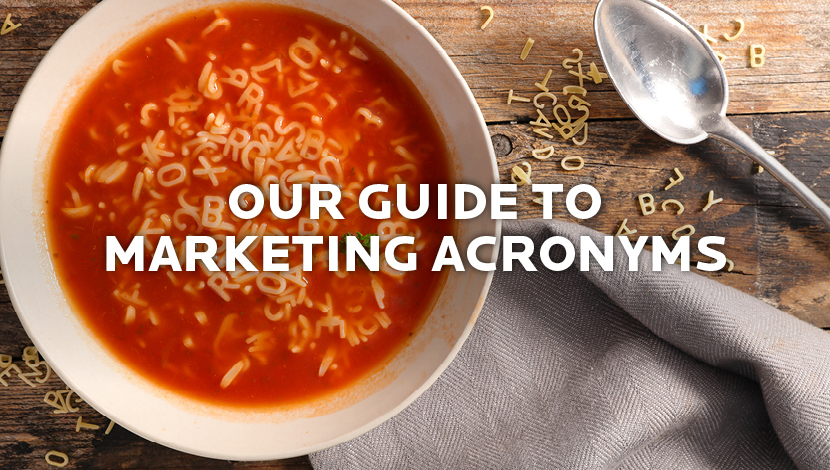
Our quest for brevity has created a virtual alphabet soup of insider jargon. Acronyms are great for quick notes, status updates, and tweets, but they are hard to swallow for those not in the know.
To help savvy business leaders and ambitious do-it-yourselfers stay on top of their game,
we deconstructed 14 of our most used acronyms pertaining to online interfaces.
What is AI?
AI or artificial intelligence is an umbrella term based on the idea of building machines capable of thinking, acting and learning like humans.
In marketing AI is used to gain customer insights, automate tasks and improve workflow.
What is AR?
AR or augmented reality adds digital elements to a live view often through a device like a smartphone. Companies like Rayban and Ikea are using AR to allow you to virtually place the image of their product in your home or on yourself before you buy.
There are also fun examples like Snapchat filters or this amazing bus stop Pepsi installed in London a couple of years ago.
https://www.youtube.com/watch?time_continue=93&v=Go9rf9GmYpM
What is CTA?
CTA or call-to-action is a text link, button, image, or some other type of web link that encourages a website visitor to take an action on that website, such as visiting a landing page to download a piece of content.
For example: Learn more about Flint’s services!
What is CPM?
CPM stands for cost per thousand. CPM is a marketing term used to indicate the price of 1,000 advertisement impressions on one webpage. If a website publisher charges $1.00 CPM, that means an advertiser must pay $1.00 for every 1,000 impressions of its ad. The “M” in CPM represents the Roman numeral for 1,000.
What is PPC?
PPC stands for pay-per-click, a model of internet marketing in which advertisers pay a fee each time one of their ads is clicked. Essentially, it’s a way of buying visits to your site, rather than attempting to “earn” those visits organically.
Search engine advertising is one of the most popular forms of PPC. Check our blog on Google Ads to learn more.
What is an RSS feed?
An RSS feed or rich site summary is a web feed publishing updated information like blog posts, news stories, and podcasts. RSS feeds let publishers syndicate data automatically, which is why they’re sometimes known as “Really Simple Syndication.” When you subscribe to a website’s RSS, you no longer need to check their website for new content — instead, your browser will automatically monitor the site and give you updates.
What is SEM?
Search Engine Marketing or SEM is a form of
online marketing to promote websites by increasing their visibility in search engine results pages (see SERPs).
What is SEO?
SEO is search engine optimization. The difference between SEO and SEM is simply that search engine optimization is part of search engine marketing or search marketing as it is widely known. Both processes work to increase visibility in search engines. SEO involves other methods that can get you more search engine visitors like PPC advertising.
What is SERP?
SERP or search engine results pages are the pages displayed by search engines in response to a query by a searcher. The main component of the SERP is the listing of results that are returned by the search engine in response to a keyword query. SERP may also contain advertisements as well.
What is UGC?
UGC or user-generated content is any content created by your customers or fans for their social channels and blog posts. It is literally the act of users promoting a brand rather than the brand promoting itself.
Companies like Oiselle are capitalizing on UGC by creating a dedicated community around their brand. Fans are encouraged to use #oisellevolee #fly when posting photos of themselves doing amazing things in Oiselle gear.
What is UI?
UI or user interface refers to everything designed into an information device with which a person may interact. This can include display screens, keyboards, a mouse and the appearance of a desktop. It is also the way through which a user interacts with an application or a website. A good user interface provides a user-friendly experience by allowing the user to intuitively interact with the software or hardware.
What is UX?
UX or user experience is the emotional response a person has with a particular business, from their discovery and awareness of the brand all the way through their interaction, purchase, use, and potential advocacy.
What is VR?
VR or virtual reality immerses users in a fully artificial digital environment. This is different from AR. AR overlays virtual objects on the real-world environment. For example, VR allows you to see what it looks like to be caught in an avalanche. AR allows you to watch the snow falling inside your office.
VR provides a more robust user experience but because of the needed device, it is more restrictive for marketing purposes than AR.
What is WCAG?
WCAG stands for web content accessibility guidelines. These guidelines were created by individuals and organizations from around the world to ensure content accessibility.
Providing content that is accessible to a larger audience is not only good for business, but these changes also often improve the experience for all users.
We have provided a reference guide to help your web team create or modify your website for compliance.
Still curious about the world of marketing and how it pertains to your business? We’d love to hear from you!
